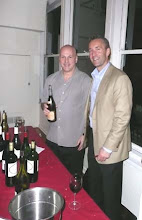
The holiday season is now upon us, and there are always different opinions on which wines go well with the typical holiday fare (turkey, ham, and all the accompanying side dishes with their varying taste profiles). We will try to keep this as a running list throughout the course of the season. I will start off by saying there are very few disastrous pairings- and of course, everyone's personal preferences will supersede even the most well known, traditional pairings. In general terms, the main course is somewhat neutral, meaning there are no strong or robust flavor characteristics to contend with. That would usually dictate that an extremely big, forceful wine of any color, such as a young California Cult Cab (or equally tannic equivalent red from elsewhere) or a heavily-oaked Chardonnay, would overwhelm the meal. This would seem to suggest a medium bodied red, rose, or white selection, or a more mature Cabernet Sauvignon (or other big structured red wine) which has fully integrated most of it's exuberant tannins. This would give us a proper weight balance. When we move on to flavor profile, in general, the same would apply here-bold, robust flavors would overwhelm the meal. It even becomes more intricate when the sides are added (for example cranberries) since they could clash with certain wines. The upside of the many flavors in the side dishes, is that it allows more freedom of flavor choices in the wines as well, since the palate will be use to so many different sensations. Within the parameters listed above, this gives you a range of many wines to choose from- whites, roses, or reds from all over the world, with vast flavors which will accentuate or embellish the ones on the dinner table. We will be adding specific wines we have had over the next few weeks (we even hosted an event a few years ago where we paired wines with the typical Thanksgiving/Holiday foods) and describing how they worked in our Holiday meal experiences.






